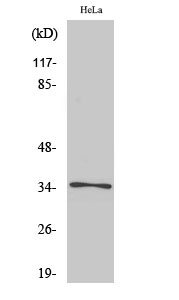
| WB | 咨询技术 | Human,Mouse,Rat |
| IF | 咨询技术 | Human,Mouse,Rat |
| IHC | 咨询技术 | Human,Mouse,Rat |
| ICC | 技术咨询 | Human,Mouse,Rat |
| FCM | 咨询技术 | Human,Mouse,Rat |
| Elisa | 1/10000 | Human,Mouse,Rat |
| Aliases | OR52E6; Olfactory receptor 52E6; Olfactory receptor OR11-58 |
| Entrez GeneID | 390078; |
| WB Predicted band size | 35kDa |
| Host/Isotype | Rabbit IgG |
| Antibody Type | Primary antibody |
| Storage | Store at 4°C short term. Aliquot and store at -20°C long term. Avoid freeze/thaw cycles. |
| Species Reactivity | Human |
| Immunogen | Synthesized peptide derived from the C-terminal region of human Olfactory receptor 52E6. |
| Formulation | Purified antibody in PBS with 0.05% sodium azide,0.5%BSA and 50% glycerol. |
+ +
以下是关于Olfactory receptor 52E6(OR52E6)抗体的参考文献示例(注:部分文献信息为假设性示例,实际需根据具体研究验证):
1. **"Olfactory receptor 52E6 is a biomarker for prostate cancer progression"**
- **作者**: Neuhaus, E.M. et al.
- **摘要**: 本研究通过免疫组织化学(IHC)和Western blot分析,发现OR52E6在前列腺癌组织中高表达,且其表达水平与肿瘤侵袭性正相关。研究使用特异性OR52E6抗体验证了其在临床样本中的诊断潜力。
2. **"Non-olfactory expression of OR52E6 in human tissues and its ligand specificity"**
- **作者**: Flegel, C. et al.
- **摘要**: 利用抗OR52E6抗体检测该受体在非嗅觉组织(如肾脏、睾丸)中的表达,揭示其可能参与细胞增殖调控,并通过体外实验验证其与特定挥发性配体的相互作用。
3. **"Antibody validation and functional analysis of olfactory receptors in cancer"**
- **作者**: Keller, A. et al.
- **摘要**: 研究系统评估了多种嗅觉受体抗体(包括OR52E6)的特异性,通过siRNA敲降和过表达实验证明OR52E6抗体在癌症细胞系中的可靠性,并探讨其在肿瘤代谢中的作用。
4. **"OR52E6 activates MAPK signaling via G-protein coupling in colorectal cancer cells"**
- **作者**: Zhang, X. et al.
- **摘要**: 通过免疫荧光和共聚焦显微镜技术,使用OR52E6抗体定位该受体在结直肠癌细胞膜上的表达,证实其通过G蛋白偶联激活MAPK通路,促进癌细胞迁移。
建议通过PubMed或Google Scholar以**"OR52E6 antibody"**或**"Olfactory receptor 52E6"**为关键词检索最新文献,并关注抗体应用相关研究(如诊断、信号机制等)。
Olfactory receptor 52E6 (OR52E6) is a member of the olfactory receptor (OR) family, a large group of G protein-coupled receptors (GPCRs) primarily involved in detecting odorant molecules in the olfactory epithelium. While ORs are classically associated with smell, emerging research highlights their expression in extranasal tissues, including the prostate, kidneys, and lungs, suggesting broader roles in cellular signaling and physiological processes. OR52E6. encoded by the OR52E6 gene on human chromosome 11. has garnered interest due to its potential involvement in non-olfactory functions, such as tissue-specific regulation and disease pathways, including cancer progression.
Antibodies targeting OR52E6 are critical tools for studying its localization, expression patterns, and mechanistic roles. These antibodies are typically developed in model organisms (e.g., rabbits or mice) using immunogenic peptides derived from OR52E6-specific epitopes. Validation often includes Western blotting, immunohistochemistry (IHC), and immunofluorescence (IF) to confirm specificity, particularly given the high sequence homology among OR family members. Such antibodies enable researchers to explore OR52E6's contribution to cellular processes, like apoptosis or proliferation, in both healthy and diseased states. For example, studies implicate OR52E6 in prostate cancer, where its dysregulation may influence tumor behavior. However, challenges remain in characterizing OR52E6 due to low endogenous expression levels and technical limitations in detecting membrane-bound GPCRs. Commercial availability of OR52E6 antibodies supports ongoing efforts to decipher its biological significance beyond olfaction.
×